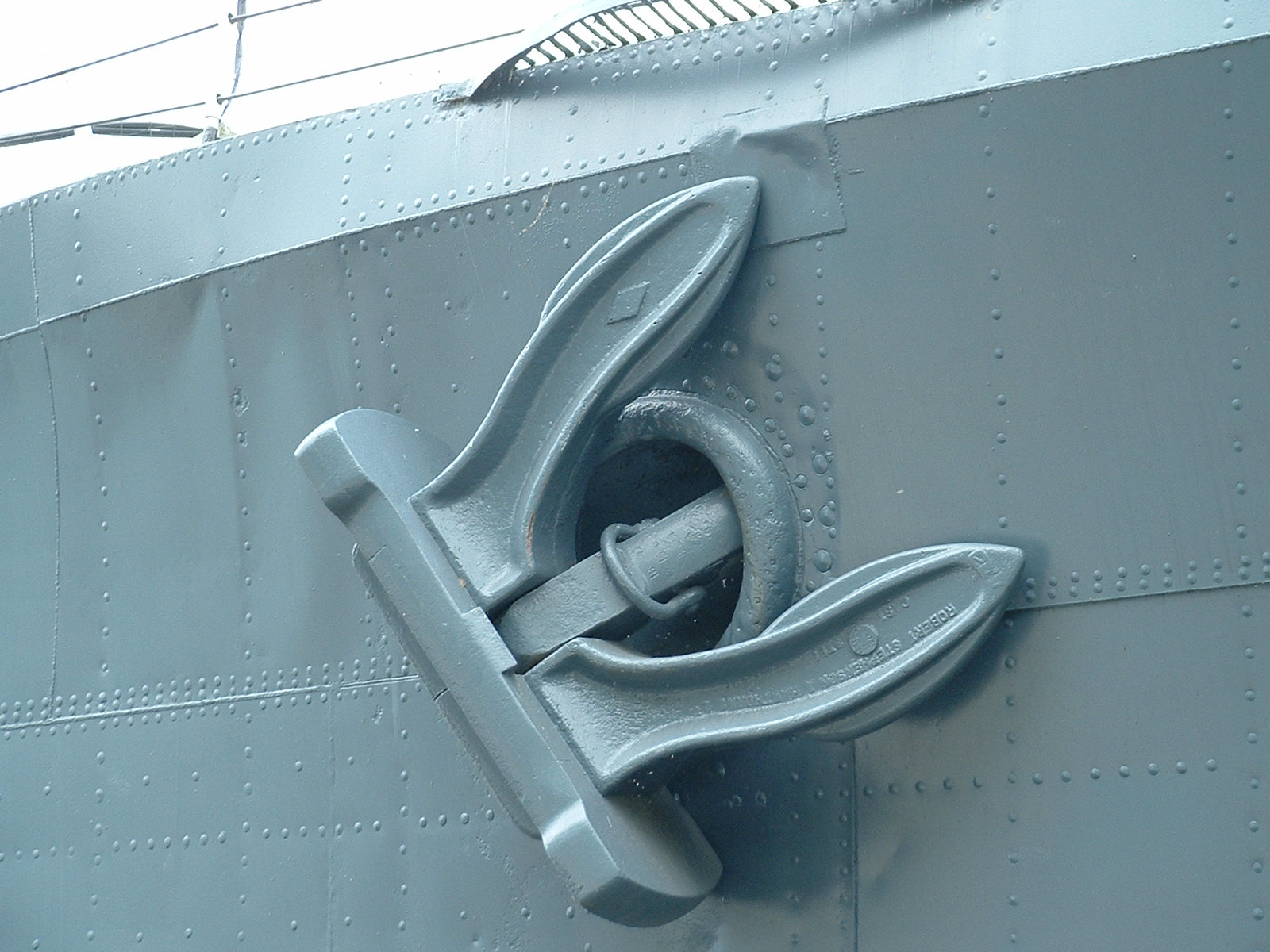Before anything else, it is important to know that in naval lingo, the entity attached to either of the bow anchors is called a cable rather than a chain. A chain is much smaller and can be man-handled . A chain locker is in a boat while a cable locker is in a ship.
 |
| Primary anchor. (1 of 2) Sometimes these were
referred to as "bowers". The anchors each weigh 36 cwt (1 cwt = 112
lbs) or 2 tons each but it is the anchor cable and not the anchor
that holds the ship in place. Each link of the cable weighs about 4.2 lbs
and the whole cable of 9 shackles (before 1949, a shackle was 12 ½
fathoms versus 15 fathoms today) was 675 feet long and weighs almost
5 tons. (Photo by Jerry Proc)
A "single anchor” was the most common way to use the anchor , but mooring using two anchors was regularly practiced, particularly where space was limited and the anchor swinging circle had to be reduced. This necessitated the use of a mooring swivel between the two cables to prevent a “foul hawse” where the cable wrapped around each other at the bow. In calm conditions, one would deploy the anchor to three times the water depth. If the seas were heavy, the anchor would be deployed to five times the water depth. The image above, of the bower anchor in the hawsepipe shows a ring on the shank. That is the “balance band” used when it's necessary to hoist the anchor on deck. There are gratings above each of the two anchors. These are called Anchor Guards and they permit someone to step over the bow see if the anchor is properly housed. |
Andy Barber served in HAIDA when she went to Korea. He recalls this about the anchors "Another feature associated with the anchors was a high pressure hose that washed the anchor and cable as they were coming up and before the cables were stored in the cable locker. This removed the sediment and any other undesirable objects that may be attached to the cables or anchors. Sometimes they had to be stopped to ensure proper cleaning. However, that didn't happen very often as the anchors were retrieved fairly slowly until the anchor reached the surface allowing for a proper cleaning.This was very important when we were anchored off of Paen Yang Do in Korea, as the Koreans used human feces as fertilizers to cultivate their crops and a lot of it was washed into the sea during rainstorms and typhoons. We could smell that island about 10 kilometers away when we were approaching it, but we anchored about 3 kms away as that was very close to North Korea and the 38th parallel. We eventually got used to the odour."
 |
| The secondary anchor, in close proximity to the Torpedo Davit and Hoist, is known as the Kedge anchor and was much smaller than the primary anchor. It weighed 560 pounds. (Photo by Jerry Proc) |
There were at least two ways of using the Kedge anchor. Jim Brewer describes one of the methods. "This anchor, was used to provide a second anchoring point in cases where it was necessary to prevent the ship from swaying should a gust of wind arise. First, the ship would drop the secondary anchor using the Torpedo Davit and Torpedo Winch. Next, the ship would steam a short distance to the primary anchoring point then drop the primary anchor. The Kedge anchor was secured to the ship by wire rope".Neil Bell describes the other method. "The kedge would be lowered to the waterline where a whaler, fitted with strongbacks athwartships, would sling the anchor underneath it. The whaler would then take the anchor to the desired position and drop it. The cable could be shackled to a length of line which could be taken forward to the windlass or handled by the torpedo winch or manually lifted from the quarterdeck".
Contributors:1) Peter Dixon
2) Jim Brewer
3) Neil Bell
4) Andy Barber
Jun 1421